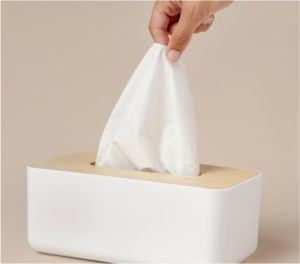Tissue Paper

Tissue paper is a lightweight paper type known for its soft texture and high absorbency. Commonly used in households and industries alike, tissue paper is indispensable for personal hygiene, cleaning, and packaging. This article explores the various types of tissue paper, their uses, and the considerations for their environmental impact.
Types of Tissue Paper[edit | edit source]
- Toilet Paper: Perhaps the most well-known type, toilet paper is essential for personal hygiene. It is designed to be soft and easily disintegrated in water to prevent plumbing issues.
- Facial Tissues: These are used for personal care, such as wiping the face or nose. Facial tissues are designed to be gentle on the skin and are often infused with lotions or fragrances.
- Paper Towels: Known for their strength and absorbency, paper towels are used for cleaning up spills and drying hands. They come in various sizes and thicknesses to cater to different needs.
- Napkins: Used during meals, paper napkins are designed to be absorbent and durable. They come in various sizes, from cocktail napkins to large dinner napkins.
- Wrapping Tissue: This type of tissue paper is thin and usually used for packaging delicate items or adding a decorative touch to gift wrapping. It is available in a variety of colors and patterns.
Uses of Tissue Paper[edit | edit source]
- Personal Hygiene: Tissue paper products such as toilet paper, facial tissues, and paper towels are essential for maintaining personal hygiene. They are used daily in households and public places.
- Cleaning: Paper towels and napkins are widely used for cleaning tasks, from wiping surfaces to absorbing spills. Their disposable nature makes them convenient for maintaining cleanliness and hygiene.
- Packaging: Wrapping tissue paper is commonly used in retail for packaging fragile items. It provides a cushioning layer that helps protect products during transit.
- Crafts and Decoration: Tissue paper is popular in arts and crafts for making decorations, paper flowers, and other creative projects. Its lightweight and easy-to-manipulate properties make it a favorite among crafters.
- Medical and Industrial Applications: In medical settings, tissue paper is used for disposable linens, sterile wraps, and other applications where hygiene is critical. In industries, it can be used for polishing and cleaning delicate equipment.
Environmental Impact[edit | edit source]
The production and disposal of tissue paper products have notable environmental impacts. Here are some considerations:
- Resource Use: Tissue paper production consumes significant amounts of water, energy, and raw materials, primarily wood pulp. Sustainable practices, such as using recycled materials and responsible sourcing of fibers, can help mitigate these impacts.
- Waste Generation: Tissue paper is designed to be disposable, leading to large amounts of waste. While some tissue paper products are biodegradable, others can contribute to landfill waste if not properly managed.
- Recycling: Tissue paper made from recycled fibers helps reduce the demand for virgin materials. However, the recycling process for tissue paper can be challenging due to its short fibers and potential contamination.
- Sustainable Alternatives: To reduce environmental impact, consumers can opt for tissue paper products made from recycled materials or those certified by environmental organizations. Additionally, reducing overall usage and finding reusable alternatives where possible can contribute to sustainability efforts.
Conclusion[edit | edit source]
Tissue paper is a versatile product with a wide range of uses, from personal hygiene and cleaning to packaging and crafts. While it offers convenience and functionality, it is important to consider its environmental impact and strive for more sustainable practices. By making informed choices and supporting eco-friendly products, we can help reduce the ecological footprint of tissue paper use.